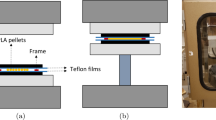Abstract
The concentration and molecular weight dependence of the self-diffusion coefficient (D self) of associative polymers of HEUR-type in aqueous solution have been investigated using FT-PGSE-NMR technique. The idea of three-dimensional network formation as a result of aggregation of the hydrophobic end-groups of the polymer in junctions is supported through the observed dramatic lowering ofD self with increased concentration. The network-formation efficiency depends on the polymer molecular weight as well as the hydrophobicity of the end-groups.
A double logarithmic dependence of the self-diffusion coefficient versus concentration (c) has been observed:D self∝c −a1,a2. The first exponent,a 1, is valid at low concentration, <1% polymer per weight solution, and ranges from 0.5 to 1, whereas the second exponent,a 2, describing systems of higher concentration, ranges from 2 to 2.7.
Similar content being viewed by others
References
Schwab FG (1986) In: Glass JE (ed) ACS Adv Chem Ser 213, Washington DC, Chapter 19
Jenkins RD, PhD Thesis (1990) The Fundamental thickening Mechanism of Associative Polymers in Latex Systems, a Rheological Study. Lehigh Univ, Bethlehem, USA
Jenkins RD, Silebi CA, El-Aasser MS (1989) Polym Mat Sci Eng 61:629
Thibenault JC, Sperry PR, Schaller EJ (1986) In Glass JE (ed) ACS Adv Chem Ser 213, Washington DC, Chapter 20
Bielmann JH, Riesthuis FJJ, van den Velden PM (1986) Polym Paints Colours J 176(4189):450
Wang Y, Winnik MA, (1990) Langmuir 6(9):1437
Char K, Frank CW, Gast AP, Tang WT (1987) Macromolecules 20(8):1833
Richey B, Kirk AB, Eisenhart EK, Fitzwater S, Hook JWJ Coat Tech (in press)
Stilbs P (1987) Progr in NMR Spectroscopy 19:1
Klein J (1979) Contemp Phys 20(6):611
Fonnum G (1989) “Syntese og Reologiske Undersøkelser av Assosiative Tyckningsmidler til Vannbaserte Maligner”, Ph.D. Thesis Institute of Organic Chemistry, Norway Techn Univ, Trondheim, Norway
Huldén M, personal communication
Callaghan PT, Le Gros MA, Pinder DN (1983) J Chem Phys 79(12):6376
Heink W, Kärger J, Pfeifer H (1990) J Chem Soc Chem Commun p 1454
von Meerwall ED (1982) J Magn Reson 50:409
Packer KJ, Rees C (1972) J Colloid Interface Sci 40:206
Callaghan PD, Pinder DN (1985) Macromolecules 18:373
Fleischer G (1985) Macromol Chem Rapid Comm 6:463
de Gennes PG (1976) Macromolecules 9:587
de Gennes PG (1976) Macromolecules 9:594
Léger L, Hervet H, Rondelez F (1981) Macromolecules 14:1732
Callaghan PG, Pinder DN (1981) Polymer Bull 5:305
Author information
Authors and Affiliations
Rights and permissions
About this article
Cite this article
Persson, K., Abrahmsén, S., Stilbs, P. et al. The association of urethane-polyethyleneoxide (HEUR) thickeners, as studied by NMR self-diffusion measurements. Colloid Polym Sci 270, 465–469 (1992). https://doi.org/10.1007/BF00665990
Received:
Accepted:
Issue Date:
DOI: https://doi.org/10.1007/BF00665990




